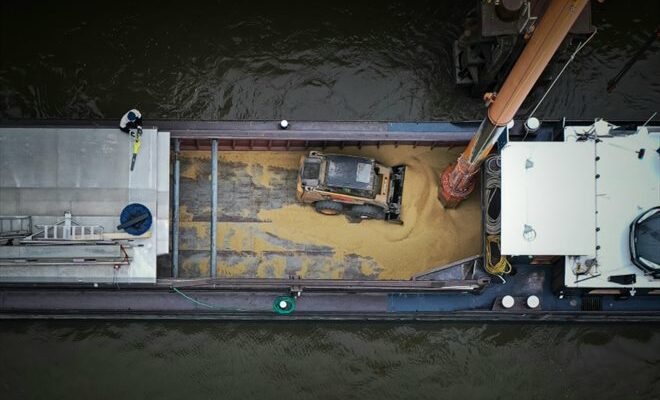A cargo of barley, transported by barge, unloaded on the site of the agro-logistician Sénalia, on January 27, 2023 at the port of Rouen (AFP / Lou BENOIST)
A mountain of barley is unloaded from a barge, a chain of trucks comes to deliver its grain: the leading grain port in Western Europe, Rouen experienced a prosperous year which saw the war in Ukraine propel France to the 4th world rank of wheat exporters.
On the quay of the Boulevard maritime, the din of the vacuum cleaner drowns out the cries of the birds. As the hold empties, the grains extracted from the boat spin on a conveyor belt to reach a cell in the huge neighboring silo.
Everything is controlled from the control room of Sénalia, the port’s leading agro-logistician: behind his screens, the controller orchestrates the entry and exit of grain, stored in towers over 80 meters high at the Grand-Couronne grain terminal. (Seine Maritime).
On its dashboard, dozens of circles represent the storage cells: rapeseed appears in green, soft wheat is blue and barley orange (fodder) or yellow (malting).
“The port of Rouen represents half of French cereal exports and Sénalia represents half of this activity”, explains Alain Charvillat, head of cereal exports for the service provider, which loaded more than 4 million tonnes in 2021-22, i.e. one million more than the previous campaign.

Aerial view of the Sénalia site, the leading agro-logistician, in the port of Rouen, January 27, 2023 (AFP / Lou BENOIST)
In 2022, France exported 11 billion euros in cereals (+ 60% over one year): “an unprecedented year”, soberly comments Jean-François Loiseau, the president of Intercéreales, which federates the cereal professions of France .
This “quite exceptional context” is “linked to the war in Ukraine” which upset the wheat routes and favored French exports while the prices of bread cereal rose from 200 to 400 euros per tonne from July 2021 to May 2022, he explains.
The six grain terminals in the port of Rouen were running at full speed: “At the beginning of the summer, there was not yet the maritime corridor allowing exports from Ukraine (opened on August 1), many buyer countries had fears of a supply disruption and turned to France”, recounts Manuel Gaborieau, head of cereal development at Haropa Port, the public establishment which brings together the ports of Le Havre, Rouen and Paris.
– “Strike force” –
“We had unusual destinations like Pakistan, Iran, India or Saudi Arabia. Countries like Algeria, which had turned more towards the Black Sea, came back”, details-t- it, highlighting an “absolute record” for loadings in the first half (5 million tonnes), traditionally the quietest.

Cereals on a conveyor belt at the Senelia site, January 27, 2023 at the port of Rouen (AFP / Lou BENOIST)
How did this port at the bottom of the estuary, located 150 km from the sea going up the loops of the Seine, become this stronghold of world cereals?
“It’s an old story,” says Manuel Gaborieau. “We have been landing there for more than 2000 years. In Antiquity, wine and olive oil transited there to Great Britain, wood and copper to the continent”.
The old Rotomagus has become a market: destroyed by the Vikings, it was the capital of the Dukes of Normandy and for a long time the first port of the kingdom. It was at the end of the 19th century that the damming up of the Seine began, then a free river like the Loire still is.

Grain silos on the site of the agro-logistician Sénalia, in the port of Rouen, on January 27, 2023 (AFP / Lou BENOIST)
After the Second World War, and the destruction of part of the port by the Allied bombings, it was the great French grain farmers who weighed in to rebuild the port, preferred to Le Havre, and give it its first silo (1958).
“Our enormous strike force is to be attached to the largest French cereal production region”, underlines Alain Charvillat. “The calculation of the Beaucerons was that it is easier to move grain by boat than by truck. A 30,000 tonne boat is 1,000 trucks”.
Stretching over 15 km, the port of Rouen, which today employs more than 18,000 people from the docks to the surrounding processing plants, has a major asset: its storage capacity (900,000 tonnes for cereals) and loading (110,000 tons per day).
“In Europe, only the Romanian port of Constanta has these capacities”, emphasizes Manuel Gaborieau.

A cargo of barley, transported by barge, unloaded on the site of the agro-logistician Sénalia, on January 27, 2023 at the port of Rouen (AFP / Lou BENOIST)
Only downside, a draft of 11.3 meters, which does not allow loading more than 55,000 tons: the largest bulk carriers therefore leave Rouen not entirely full and complete their loading in a deep water port, such as Dunkirk or La Rochelle.
On the quays of Rouen, a tractor scrapes the bottom of a barge. Every grain counts. Here, no one dares to say it, but the continuation of the war 2000 km away, augurs well for a new year “if the harvest is there this summer”.
© 2023 AFP
Did you like this article ? Share it with your friends with the buttons below.




